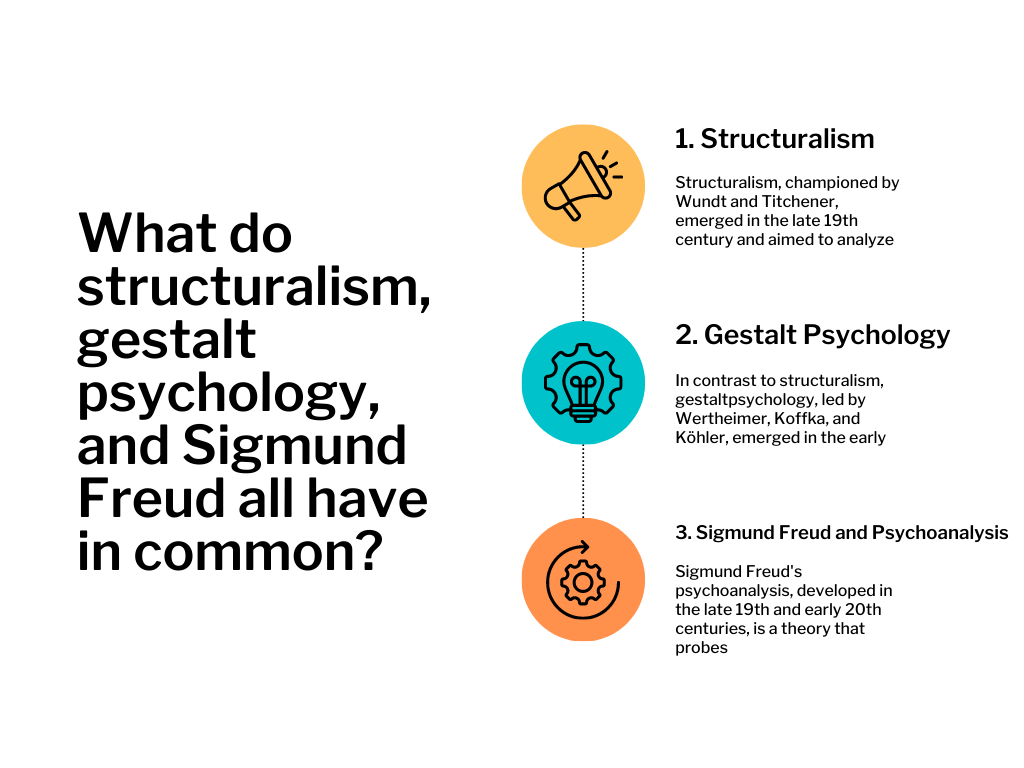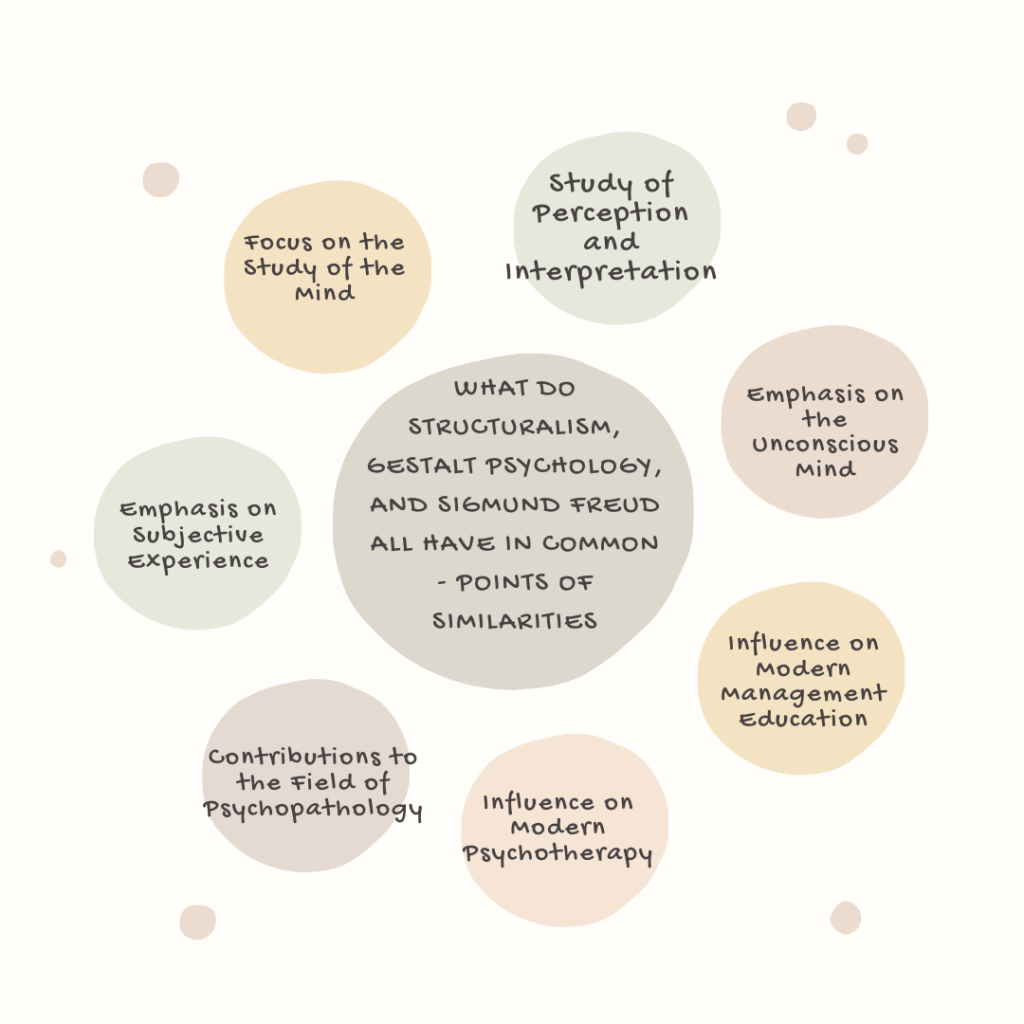What do structuralism, gestalt psychology, and Sigmund Freud all have in common?
gestalt psychology: In the realm of management education, an understanding of various psychological theories can provide valuable insights into human behavior and decision-making. Three prominent theories, namely structuralism, gestalt psychology, and Sigmund Freud’s psychoanalysis, have significantly contributed to our understanding of the human mind. While seemingly different, these theories share common ground in their approach to analyzing and interpreting human experiences. In this article, we will delve into these three theories and uncover their shared characteristics, highlighting the relevance of their principles in management education.

1. Structuralism:
Structuralism, championed by Wundt and Titchener, emerged in the late 19th century and aimed to analyze the structure of the human mind. Structuralists believed in breaking down experiences into elemental components to understand their underlying structure. This theory emphasized introspection, the systematic examination of one’s thoughts and feelings, as a means of capturing the structure of consciousness.
2. Gestalt Psychology:
In contrast to structuralism, gestaltpsychology, led by Wertheimer, Koffka, and Köhler, emerged in the early 20th century and focused on the holistic interpretation of human perception and experiences. Gestalt theory posits that humans naturally organize perceptions into meaningful wholes, emphasizing the “gestalt” or overall pattern, rather than individual elements. This theory stresses the importance of context, cognition, and the understanding of the whole being greater than the sum of its parts.
3. Sigmund Freud and Psychoanalysis:
Sigmund Freud’s psychoanalysis, developed in the late 19th and early 20th centuries, is a theory that probes deep into the unconscious mind, exploring hidden desires, conflicts, and motivations. Freud believed that human behavior stems from the interplay between conscious and unconscious thoughts, emphasizing the role of sexuality and the importance of unconscious processes in shaping personality. Psychoanalysis aimed to uncover repressed memories and desires through therapeutic techniques such as dream analysis, free association, and transference.
What do structuralism, gestalt psychology, and Sigmund Freud all have in common – Points of Similarities

Focus on the Study of the Mind
All three approaches—structuralism, Gestalt psychology, and Freudian psychoanalysis—share a fundamental interest in the study of human consciousness, albeit from different perspectives. Structuralism, founded by Wilhelm Wundt, addresses the study of the mind’s structure through the analysis of conscious experiences. Gestalt psychology focuses on understanding how the mind organizes and perceives information as a whole, emphasizing the Gestalt principles of perception. Freudian psychoanalysis delves into understanding the unconscious mind and its influence on human behavior.
Study of Perception and Interpretation
Both structuralism and gestalt psychology aimed to analyze human perception, albeit from different perspectives. Structuralists sought to break down experiences into their elemental components, while gestalt psychologists emphasized the importance of holistic perception and the role of context. Similarly, psychoanalysis delves into the interpretation of unconscious desires and motivations, seeking to understand the underlying meanings behind our actions.
Emphasis on the Unconscious Mind
While structuralism and gestalt psychology primarily focused on conscious experiences, Freud’s psychoanalysis delved deep into the realm of the unconscious. All three theories acknowledge the impact of unconscious processes on human behavior and recognize the significance of uncovering hidden motives and conflicts.
Influence on Modern Management Education
The principles of these theories extend beyond the realm of psychology and have permeated management education. Understanding the structural composition of organizations, the interpretation of organizational culture, and uncovering employees’ underlying motivations are all crucial for effective management. By embracing ideas from structuralism, gestalt psychology, and psychoanalysis, management professionals can gain deeper insights into individual and collective behavior, thus enhancing their decision-making processes.
Influence on Modern Psychotherapy
Structuralism, Gestalt-psychology, and Freudian psychoanalysis have had a lasting impact on the development of modern psychotherapy. Structuralist ideas are still present in cognitive-behavioral therapy, where the analysis of conscious experiences and their patterns plays a crucial role. Gestalt principles of perception are integrated into various forms of therapy that focus on promoting holistic understanding and self-awareness. Freud’s psychoanalytic concepts are utilized in psychodynamic therapy and continue to shape contemporary psychotherapy approaches.
Contributions to the Field of Psychopathology
All three approaches have significantly contributed to the understanding of psychopathology, emphasizing the role of mental disorders and abnormal behaviors. Structuralism’s focus on introspection has paved the way for studying the subjective experiences associated with mental illnesses. Gestalt-psychology has offered insights into perception disorders and the impact of disrupted gestalt organization on mental health. Freud’s psychoanalysis, with its emphasis on the unconscious mind, has illuminated the influence of repressed memories and unresolved conflicts on mental disorders.
Emphasis on Subjective Experience
Another commonality between the three approaches is their recognition of the importance of subjective experiences in comprehending human consciousness. Structuralism aims to systematically analyze individual experiences, breaking them down into their basic components. Meanwhile, Gestalt-psychology focuses on the holistic perception of objects and events, emphasizing that the whole is more than the sum of its parts. Freudian psychoanalysis explores the unconscious mind and its influence on human behavior, revealing the existence of hidden motives and desires.
Case Study: Utilizing Psychoanalytic Concepts in Organizational Development
One practical application of these theories is in the field of organizational development. Companies like Google have adopted psychoanalytic concepts to foster a more inclusive and productive working environment. By encouraging employees to engage in reflection, free association exercises, and emotional expression, organizations can promote self-awareness, uncover hidden conflicts, and cultivate a healthy workplace culture.
Conclusion
While structuralism, gestalt-psychology, and psychoanalysis may appear distinct at first glance, they share common ground in their exploration of the human mind. Through their unique lenses, these theories have contributed to our understanding of perception, interpretation, and the influence of the unconscious on human behavior. Incorporating these insights into management education can provide valuable tools for understanding and leading individuals and organizations effectively. By embracing this interdisciplinary approach, management professionals can gain a deeper understanding of human psychology and use it to drive organizational success
Samrat is a Delhi-based MBA from the Indian Institute of Management. He is a Strategy, AI, and Marketing Enthusiast and passionately writes about core and emerging topics in Management studies. Reach out to his LinkedIn for a discussion or follow his Quora Page

